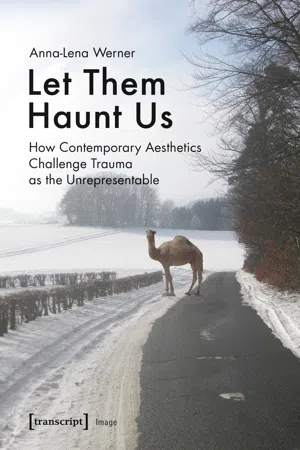
eBook - PDF
Image
How Contemporary Aesthetics Challenge Trauma as the Unrepresentable
This is a test
- English
- PDF
- Available on iOS & Android
eBook - PDF
Book details
Book preview
Table of contents
Citations
About This Book
Let Them Haunt Us analyzes contemporary aesthetics engaged in trauma and critically challenges its canonical status as »unrepresentable«. Focusing on case studies in the aesthetic practices of Janet Cardiff and George Bures Miller, Omer Fast, Forensic Architecture, and Paul McCarthy this book proposes to redefine trauma as a productive framework to exploring individual, collective, and cultural conflicts addressed in current artistic and curatorial practices. Anna-Lena Werner considers the aesthetic realm as a potential forum that provides methods of understanding the humanitarian consequences of violence and warfare, and to reveal the effects of trauma on visual culture, collective memory, and politics.
Frequently asked questions
At the moment all of our mobile-responsive ePub books are available to download via the app. Most of our PDFs are also available to download and we're working on making the final remaining ones downloadable now. Learn more here.
Both plans give you full access to the library and all of Perlego’s features. The only differences are the price and subscription period: With the annual plan you’ll save around 30% compared to 12 months on the monthly plan.
We are an online textbook subscription service, where you can get access to an entire online library for less than the price of a single book per month. With over 1 million books across 1000+ topics, we’ve got you covered! Learn more here.
Look out for the read-aloud symbol on your next book to see if you can listen to it. The read-aloud tool reads text aloud for you, highlighting the text as it is being read. You can pause it, speed it up and slow it down. Learn more here.
Yes, you can access Image by Anna-Lena Werner in PDF and/or ePUB format, as well as other popular books in Art & Art Theory & Criticism. We have over one million books available in our catalogue for you to explore.
Information
Trauma
Spaces
157
Image
19
&
20:
Paul
McCarthy.
Pinocchio
Pipenose
Household
Dilemma
(1994).
Photo:
Paul
Mc-
Carthy/Karen
McCarthy.
e
sound,
too,
changes
when
heard
from
behind
the
mask:
not
only
does
the
video
feature
squeaking
and
hollow
sounds
due
to
recording
in
a
small
wooden
cabin,
but,
according
to
Schröder,
this
ef
fect
is
amplified
from
under
the
mask,
creating
sounds
that
seem
unreal,
dreamlike
and
distant.
15
At
the
same
time,
however,
the
physical
situation
suggests
an
elimination
of
distance
and
a
f
fords
an
entrance
into
Pinocchio’s
spatial
nightmare.
By
providing
the
obligatory
mask,
McCarthy
simultaneously
enforces
a
percep-
tual
alienation
between
observing
self
and
world,
a
failure
of
identification
between
perception
and
representation
of
self.
Viewers
are
confronted
with
an
ambivalent
situation:
they
visually
and
spatially
identify
with
their
double
on
the
screen,
but
are
all
the
while
alienated
by
its
childish
and
obscene
behaviour.
Pinocchio’s
actions
are
innocent
–
in
principle
–
but
their
symbolism
isn’t:
he
has
an
interpersonal
relationship
with
another
replica
–
his
playmate,
the
doll
–
but
his
actions
and
genen
Atem
und
das
Zischen
der
Luft,
die
durch
die
Augenlöcher,
die
lange,
rohrartige,
hohle
Nase
und
den
Hals
in
die
Maske
strömt.”
15
Cf.
Schröder
(1995),
190.
Table of contents
- Cover
- Contents
- Acknowledgements
- Introduction
- A History of Trauma
- Challenging Trauma as the Unrepresentable
- Trauma Narratives
- Trauma Spaces
- Trauma – Curational Perspectives
- Conclusion and Outlook
- Bibliography
- List of Figures